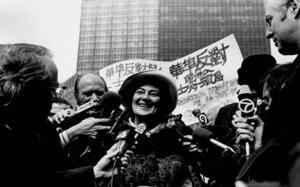The times and places with which they are identified had little in common: Persia in the 5th Century BCE and the United States in the 20th Century CE. Bella Abzug was a central figure in the emergence of second wave US feminism, while Esther’s biblical Shushan was a society where women could be legally banished for disobeying their husbands. While Bella’s husband, Martin, did household tasks so his wife could be a successful attorney and member of the U.S. Congress, Esther spent a year beautifying herself in the palace before her one chance to prove herself worthy of being chosen by King Ahasuerus to be his queen.
Still, their narratives have similarities. Both Bella Abzug and Esther were courageous women, involved in high stake political power struggles. Both women took a stand for the Jews. They each faced discrimination towards women. Each of them used their wits in threatening situations. And both women chose an appearance and a persona that helped them to achieve their goals.
What lessons do Esther and Bella Abzug each have to teach us about leadership? How did their dress either hide or reveal their true selves? What messages did their “costumes” send? Let’s look at their stories to answer these questions.
According to the megillah, the biblical Esther hid her true identity. She wore the “mask” of a Gentile when she entered King Ahasuerus’s court. She also took on the appearance of a docile and obedient queen. However, as the Purim story unfolds, Esther’s disguises fall away. She reveals her courage when she risks her life to approach King Ahasuerus. As the Purim story reaches its climax, Esther discloses her Jewish identity, and in doing so she wins the safety of the Jewish people.
Now let’s fast forward approximately 25 centuries to Bella Abzug, who was born in 1920 in the Bronx. Abzug contested society’s expectations for women in order to battle for justice directly and publicly. Her appearance, manner, and words all communicated a message of liberation. She refused to hide her strength, intelligence, love of life, and fury.
When Bella Abzug was a young attorney, people often ignored and dismissed her, mistaking her for a secretary. To overcome this discrimination, she decided to wear a hat and gloves so that people would see her as a professional. By the time Abzug became a prominent political figure in the 1970s, a hat no longer symbolized the professional role which she had sought to represent. By then, her flamboyant hats had become a singular emblem that symbolized her bold, valiant, and indefatigable spirit. Thus, her costume allowed her to be seen as the truly powerful woman she was.
Abzug began to challenge societal expectations of women early in her life. Abzug treasured her Jewish upbringing. As a girl she regularly went to synagogue with her grandfather and memorized the prayers. Abzug was influenced by the Jewish values her father exemplified, of loving peace and offering respect to everyone. But when her father died when she was twelve, Bella defied tradition to say Kaddish (a prayer for mourners) for him every day for a year in the Orthodox synagogue in which she was raised. From her Jewish upbringing, Abzug derived both a belief in justice and a commitment to seeing that no one should be excluded from its benefits and responsibilities.
From childhood, Abzug aspired to become an attorney. When she was rejected from Harvard Law School, because it didn’t admit women, she went to Columbia University’s law school on a scholarship at a time when few lawyers were women.
Abzug took vocal and visible stands on the issues of civil rights, the environment, women’s rights, nuclear weapons, the Vietnam War and gay rights. She was one of the few attorneys willing to fight against the House Un-American Activities Committee during the McCarthy era. In 1950, Abzug risked her life in Mississippi to plead for clemency in a rape trial against a black man. Pregnant and alone, she spent the night locked in a bathroom in a bus station to avoid the Ku Klux Klan.
Abzug also fought for the Jewish people. She called for freedom for Soviet Jewry and supported aid to Israel. She led the fight to condemn the UN General Assembly’s 1975 resolution which equated Zionism with racism.
Both biblical Esther and Bella Abzug consciously chose images that could help them win important battles. What lessons do they have to teach us? How do women today hide their identities in order to fight for justice? When does our dress become a message of freedom and when does it distract people from hearing important messages? How do women of today alter their appearance to conform to society’s image of beauty? These are some questions that Purim and these two inspiring women pose to us today.



